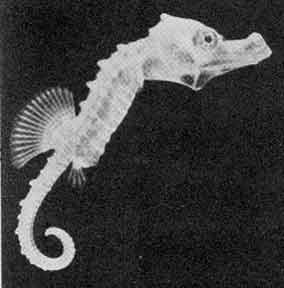A Motherly Knight in Armor, Page 4
By WILLIAM BEEBE
Page 1 | Page 2 | Page 3 | Page 4
At four o'clock two more young seahorses slipped out of the opening of the pouch corral. This was distended and throbbing with life-the pressure and struggles of little heads and bodies being plainly discernible on the surface as intermittent dimples and bulges. A few minutes later a loud cry arose from my watcher and an instant after, with my hand lens, I was at the aquarium.
The parent Hippocampus had taken a firm grip with his tail around the branch of a sea-fern near the bottom and was swaying back and forth with head drawn in and the body and pouch pushed far forward. As I watched, the body was drawn back, and then, every muscle being brought into play, his whole being again strained forward. The upper third of the pouch which usually shows as a deep fold down the middle was now distended to the full, and in the center was revealed a small round orifice. As the pouch reached its utmost distention, the opening enlarged slightly and with a convulsive movement there was ejected a mass, a mist, a whole herd of young. They were thrown into the world in the shape of a rounded ball, which, like a smoke-ring or a bomb from a firework, held together as it moved rapidly upward and obliquely forward through the water. Only when it began to lose impetus, ten or twelve inches away, did it spray out into long streamers and scattered blobs of infant Pegasi. From the moment of slackened paternal impulse the individual. seahorse motes assumed individual activity, swimming, twining their tails around themselves and one another, lashing out from side to side for all the world like diminutive crocodiles. With all this casual, indirective movement there was a steady stampede of each successive herd toward the surface; a scientist would describe it as positively phototropic.

Five more parental, H E ejections took place before the pouch was empty, and the fourth and fifth were both still ball-like, revolving slowly upward, while the earlier ones had spread out into a subsurface film of frisking young Hippocampi.
The pouch did not collapse as I expected it would, but for another half hour was only slightly shrunken. Yet the last of the young had emerged three hundred and six in all. This was the end, and in the morning the parent's pouch was indistinguishable and the green color had given way to a suit of dark brown, starred with white and faced with yellow-green. And father and young were doing well.
The story was once told and has been repeated many times of how the young seahorses return, at the approach of danger, to their father's pouch. It is a charming idea but is quite untrue. There is no bond between offspring and parent once they are shot out of his pocket, and their instinct to swim up to the surface and toward the light is wholly unlike his ideas of a proper trajectory which is down and among the protective fronds of seaweed. In addition to this the opening of the pouch closes tightly immediately after the multiple births, and precludes any readmission.
There is no doubt about the interest which the life of a dolphin must hold, and I am sure that the way of a mermaid in the sea would inspire a best seller, but for charm, for quiet success in life and for sheer unexpectedness of mating, incubation and birth the seahorse has no equal. As to the questions that arise: How did this intricate and reversed relationship first come about? Why does the female hand over her eggs? Why does the male parent shelter and incubate them? Why, I can only answer, I don't know.
 Printer-friendly version
Printer-friendly version
